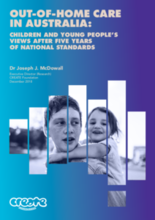In 2013, CREATE used the National Standards for Out-of-Home Care (National Standards) to produce it its first comprehensive survey on the out-of-home care system. This survey analysed findings from 1069 children and young people with a care experience on their life in care into a report titled Experiencing Out-of-Home Care in Australia: The Views of Children and Young People. In 2015, the Government also did their own survey also using the National Standards to see what needed to be improved in child protection systems.
Five years after their 2013 report, CREATE set out to conduct a follow up survey to find out what has changed since the 2013 report and the Government’s 2015 report. CREATE surveyed 1275 children and young people with a care experience with a diverse range of backgrounds. CREATE’s new report, Out-of-Home Care in Australia: Children and Young People’s Views After 5 Years of National Standards details the findings of this survey.
Key findings:
- 44% of respondents reported being aware of having a case plan, but only 43% of these had been involved in its preparation
- Children and young people in home-based care tended to have a more stable care experience than in Residential Care or Independent Living; Kinship Care respondents reported the most stable placements, with three quarters of these meeting the Standard.
- 93% of children and young people said they felt safe and secure in their current placements with 81% of respondents also indicating they felt happy in their placements.
- 36% of young people with siblings in care were separated from all their brothers and sisters.
- Carers were significantly more involved than were caseworkers in helping children and young people maintain family contact, and helping young people in their education needs.
The survey’s complete findings can be found in the standard report, while a more comprehensive snapshot of our findings is available in the young person’s report.

